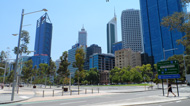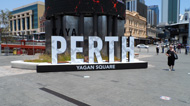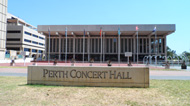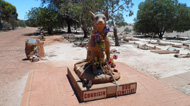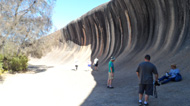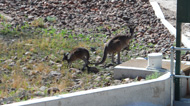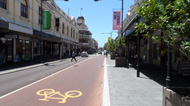
  |
AUSTRALIA
Australia, officially the Commonwealth of Australia, is a continent and a state surrounded by the Indian and Pacific oceans. It is the sixth largest country (7,617,110 sq km, mostly desert), has a population of over 25 million inhabitants, almost entirely residing on the coasts. Its main cities Sydney, Brisbane, Melbourne, Perth, Adelaide are located on the coast. The capital, Canberra, is instead inland. The country is famous for the Sydney Opera House, the Great Barrier Reef, the vast desert area called Outback and the unique species of animals, such as kangaroos and platypuses.
The country is located in the southern hemisphere, surrounded by the Indian ocean in the west and south, and the Pacific in the east. Populated by Aboriginal people for more than 40000 years, it has been colonized by the United Kingdom since the XVIIIth century. Australians, who call themselves aussie, are a multi-ethnic people, counting not only Aborigines and Europeans, but also Asians and Americans. Politically, Australia is a Federal Constitutional Monarchy. The head of state is the Queen of Australia Elizabeth II (also Queen of Great Britain), represented by a governor general.
In past centuries the name was assigned in relation to the Latin expression "terra australis incognita" (unknown southern land) which indicated an imaginary continent occupying almost the entire southern hemisphere, that is, "south" of the Earth's equator; this name derives from the Latin australis, i.e. southern, in turn from the Greek a?st????, i.e. austere, severe, rigorous, harsh, dry, because in ancient times the name indicated our or Austro, a warm wind that, still, in the Mediterranean sea, blows from the south (in Italy it is also improperly called with the names of Libeccio and Scirocco). The name of the wind in turn would derive from the Indo-European root aus-, ie burn, desiccate, from which the terms aurora and austere also derive, and it is not to be confused with the name "Austria", which instead indicates more a transliteration of the Germanic Íster, eastern, from Ost = east. The name Australia was popularized by the publication of Matthew Flinders' travel report "A Voyage around Terra Australis", released in London in 1814. The British explorer's journey was the first documented circumnavigation of Australia . Although the title reflected the name used by the Admiralty, Flinders often used the word Australia in his relationship, so that, due to the enormous success of the book, it became the name by which Terra Australis was commonly indicated. The Governor of New South Wales Lachlan Macquarie, having seen the success of the new name, suggested, on December 12, 1817, to the Secretary of State for Colonies (or Ministry of Colonies, better known as the Colonial Office) to rename the colony "Australia". In 1824 the Admiralty agreed and officially changed the name to Australia.
Australia has been inhabited for about 40,000 years, since the ancestors of the Aboriginal Australians arrived from today's Southeast Asia taking advantage of the land bridges created during the ice age, then followed by the Maori who colonized New Zealand instead. Although it was not discovered by the Europeans until the XVIIth century, the ancient Greeks and Romans had already imagined the existence of a land below Europe, the so-called Terra Australis ("southern land"), from which the name "Australia".
The first European to set foot on the "brand new continent" was in 1606 the Dutch navigator Willem Janszoon.
It is estimated that in 1788 the indigenous peoples counted between 750,000 and one million inhabitants; at the arrival of the colonists the integration was short and without great bloodshed. Today however just 2% of the Australian population is of Aboriginal ethnicity living in mostly unknown tribes.
In 1770, after the arrival of the UK naval lieutenant, James Cook, two eastern thirds of the country were reclaimed by the UK, which used them to set up penal colonies, claiming the rest in 1829. Most of the States that later federated to form Australia were not however born as criminal colonies. On January 1, 1901, the Commonwealth, or federation of Australia, was born as a domain within the British Empire. Australia was now independent, although the last legal ties with the United Kingdom were not severed until 1986.
In 1999, the population was called upon to vote on a referendum to change Australia's state form into a republic, with a president to replace the queen as head of state, however the question was rejected. Malcolm Turnbull intended to propose another, which he wished was carried out at the death or abdication of Elizabeth II of the United Kingdom, as it was his intention to remain in the Commonwealth but not to be a realm of it. The same intentions were also expressed by neighboring New Zealand and Canada, although the populations of all three Commonwealth realms still express themselves in favor of the monarchy.
Australia is defined by some scholars as a "fossil continent": this is due to the fact that most of its rocks were formed in the Precambrian, about 4.6 billion years ago, the time of formation of our planet. The country is mostly flat and has a mainly arid soil. Only the south-eastern and south-western regions have a temperate climate: due to this situation, the Australian population is concentrated in the south-east states. The north, characterized by a tropical climate, presents a landscape consisting of rain forests, mangrove swamps, grasslands and woods of other tree species. Ocean currents also influence the climate, especially El Ni˝o, related to periodic droughts. The low seasonal pressure causes cyclone showers especially in the north of the country. The Australian biome is characterized by both plant and endemic animal species, this particular flora and fauna is seriously endangered by the introduction of alien species by man. For this reason, the federal parliament has passed a law that protects Australia's particular ecosystem. The koala together with the kangaroo is an "icon" of Australia. Numerous protected areas have been created as part of a biodiversity protection project implemented by different countries around the world. Sixty-four sites (mainly marshes) have undergone special protection in accordance with the Ramsar Convention signed by Australia, while sixteen other sites have been declared World Heritage Sites by UNESCO. Australia, thanks to its commitment in the environmental field, was included in 16th place in the Environmental Sustainability Index. Most Australian plants are evergreens, and many are xerophilous (eucalyptus and acacias). In the country there are many endemic leguminous plants, which grow in soils lacking in nutrients, by virtue of their symbiosis with the Rhizobia bacteria and mycorrhizal fungi. Australian fauna with monotremes (order to which the platypus belongs), marsupials (kangaroos, koalas and wombats), freshwater crocodiles (Crocodylus johnsoni), saltwater (Crocodylus porosus) and birds like emu and kookaburra. Australia is also the country of the most poisonous snakes in the world such as taipan. The dingo was introduced by the Austronesians, people who traded with Aboriginal Australians around 3000 BC.
Distance traveled during the trip to Malaysia - Australia |
|||
# flights |
Air Company |
From >>> to |
traveled Km/flight hours |
01 |
EMIRATES - EK046 | Francoforte International > Dubai | 4.850 - 6h 20' |
02 |
EMIRATES - EK436 | Dubai > Kuala Lumpur | 5.550 - 6h 40' |
03 |
MALINDO - OD151 | Kuala Lumpur > Perth | 4.179 - 5h 35' |
04 |
JETSTAR - JQ975 | Perth > Adelaide | 2.119 - 2h 45' |
05 |
JETSTAR - JQ775 | Adelaide > Melbourne | 642 - 1h 10' |
06 |
JETSTAR - JQ664 | Melbourne > Ayers Rock (Uluru) | 1.909 - 2h 50' |
07 |
JETSTAR - JQ665 | Ayers Rock > Melbourne | 1.909 - 2h 50' |
08 |
QANTAS - QF458 | Melbourne > Sydney | 858 - 1h 30' |
09 |
QANTAS - QF532 | Sydney > Brisbane | 733 - 1h 15' |
10 |
VIRGIN AUSTRALIA - VA938 | Brisbane > Sydney | 733 - 1h 15' |
11 |
VIRGIN AUSTRALIA - VA559 | Sydney > Perth | 3.270 - 4h 20' |
12 |
MALINDO - OD152 | Perth > Kuala Lumpur | 4.179 - 5h 40' |
13 |
AIRASIA - AK5140 | Kuala Lumpur > Kota Kinabalu | 1.635 - 2h 25' |
14 |
AIRASIA - AK5133 | Kota Kinabalu > Kuala Lumpur | 1.635 - 2h 25' |
16 |
EMIRATES - EK343 | Kuala Lumpur > Dubai | 5.550 - 6h 40' |
17 |
EMIRATES - EK045 | Dubai > Francoforte International | 4.850 - 6h 20' |
| TOTAL KILOMETERS TRAVELED IN AUSTRALIA | Km. 12.173 |
||
| TOTAL KILOMETERS COVERED DURING THE ENTIRE JOURNEY | Km. 44.601 |
||
***** |
Downtown Perth |
Yagan Square |
Perth Concert Hall |
Corrigin dog cemetery |
Perth-Fremantle |
Perth is the capital of Western Australia. It is the fourth most populous city in Australia and the most populous on the west coast of the country, and its name is a tribute to the city of Perth in Scotland. The site on which Perth stands today has been occupied for thousands of years by groups of the Nyoongar tribe. Of them, and their ancestors, there are traces dating back to about 40,000 years ago. Perth was founded in 1829 as a colony on the Swan River, but grew very slowly until 1850, when convicts were brought here to make up for the shortage of manpower. Many of Perth's beautiful buildings, such as the Government House and Perth Town Hall, were built thanks to the work of the condemned. Despite this, the development of Perth was less than that of other cities in the east, until the discovery of gold in the XIXth century made the population increase four times in a decade, starting the building boom. Western Australia's mineral wealth undoubtedly contributed to Perth's growth, and around 1980 the city embodied the obsession with the fast-paced gain of that decade. A group of entrepreneurs promoted an image of Perth as a place where anyone could become a millionaire. The outbreak of Alan Bond, the beer magnate who became famous for the surprise victory of the boat he financed, Australia II, at the 1983 America's Cup was sensational. The political and union scandals that made the city tremble in recent years have added to Perth's bad reputation. In the 1990s, the liberal Richard Court government held power for a long time and accompanied the capital of Western Australia to a building boom similar to that of other Australian cities. Since the XVIIIth century Perth has been the Australian capital of the textile industry and the largest companies in the sector have been based there. In recent years Perth has become Australia's most important center for the export of mineral resources to China. The Perth metropolitan network, which includes surface trains, buses, ferries and railways, is provided by Transperth which connects the city to the surrounding areas. There are 70 railway stations and 15 bus stations in the city. In the city center, the use of public transport is free and an efficient bus system follows the east-west directive. The largest passenger and container port is located in Fremantle, 19km south-west of Perth, on the mouth of the Swan River. The Perth metropolitan area has about 2 million inhabitants (June 2014), making it the fourth largest city in Australia. After the last census in 2011, Greater Perth had 1,728,867 inhabitants with an increase in population compared to the 2006 census of 14% and an increase between 4.4 million and 6.6 million is expected by 2061. The last population census was held in 2016. The city has an international airport which is located around 12 km from the city. Taxis and buses are available and take you to the center in about half an hour. Bus # 40 takes 45 '/4.90 AU$. The taxi from the airport to he Pan Pacific Hotel along Adelaide Terrace costs AU$ 57. The pedestrian zone is Hay street where there are shops, restaurants and bars. From Perth you can make interesting excursions. An hour and a quarter boat cruise on the Swan River to Fremantle and then return by bus # 910/AU$ 4.90. Two full day excursions that are definitely worth doing are at the Pinnacles Desert (AU$ 170) and Wave Rock (AU$ 215).
